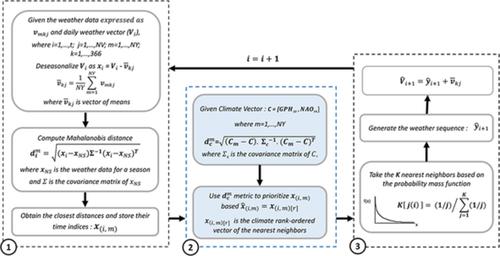当前位置:
X-MOL 学术
›
Hydrol. Process.
›
论文详情
Our official English website, www.x-mol.net, welcomes your
feedback! (Note: you will need to create a separate account there.)
Simulating precipitation in the Northeast United States using a climate‐informed K‐nearest neighbour algorithm
Hydrological Processes ( IF 2.8 ) Pub Date : 2020-07-21 , DOI: 10.1002/hyp.13853 Saman Armal 1, 2, 3 , Naresh Devineni 1, 2, 3 , Nir Y. Krakauer 1, 2, 3 , Reza Khanbilvardi 1, 2, 3
Hydrological Processes ( IF 2.8 ) Pub Date : 2020-07-21 , DOI: 10.1002/hyp.13853 Saman Armal 1, 2, 3 , Naresh Devineni 1, 2, 3 , Nir Y. Krakauer 1, 2, 3 , Reza Khanbilvardi 1, 2, 3
Affiliation

|
Decadal prediction using climate models faces long‐standing challenges. While global climate models may reproduce long‐term shifts in climate due to external forcing, in the near term, they often fail to accurately simulate interannual climate variability, as well as seasonal variability, wet and dry spells, and persistence, which are essential for water resources management. We developed a new climate‐informed K‐nearest neighbour (K‐NN)‐based stochastic modelling approach to capture the long‐term trend and variability while replicating intra‐annual statistics. The climate‐informed K‐NN stochastic model utilizes historical data along with climate state information to provide improved simulations of weather for near‐term regional projections. Daily precipitation and temperature simulations are based on analogue weather days that belong to years similar to the current year's climate state. The climate‐informed K‐NN stochastic model is tested using 53 weather stations in the Northeast United States with an evident monotonic trend in annual precipitation. The model is also compared to the original K‐NN weather generator and ISIMIP‐2b GFDL general circulation model bias‐corrected output in a cross‐validation mode. Results indicate that the climate‐informed K‐NN model provides improved simulations for dry and wet regimes, and better uncertainty bounds for annual average precipitation. The model also replicates the within‐year rainfall statistics. For the 1961–1970 dry regime, the model captures annual average precipitation and the intra‐annual coefficient of variation. For the 2005–2014 wet regime, the model replicates the monotonic trend and daily persistence in precipitation. These improved modelled precipitation time series can be used for accurately simulating near‐term streamflow, which in turn can be used for short‐term water resources planning and management.
中文翻译:

使用气候相关的K近邻算法模拟美国东北部的降水
使用气候模型进行年代际预测面临长期挑战。尽管全球气候模型可能会由于外部强迫而重现长期的气候变化,但在短期内,它们通常无法准确模拟年际气候变化,季节性变化,干湿两季和持久性,这对于水资源管理。我们开发了一种新的气候通知型钾肥基于最近邻(K-NN)的随机建模方法,可在复制年内统计数据时捕获长期趋势和变异性。具有气候信息的K-NN随机模型利用历史数据以及气候状态信息为近期区域预测提供了改进的天气模拟。每日降水和温度模拟基于模拟天气日,该模拟天气日与当年的气候状态相似。使用美国东北部的53个气象站对气候知情的K-NN随机模型进行了测试,年降水量具有明显的单调趋势。在交叉验证模式下,还将模型与原始的K-NN天气生成器和ISIMIP-2b GFDL通用环流模型偏差校正后的输出进行了比较。结果表明,气候知悉的K-NN模型可以更好地模拟干湿状况,并为年度平均降水量提供更好的不确定性范围。该模型还复制了年内降雨统计数据。对于1961–1970年的干旱状态,该模型捕获了年平均降水量和年内变化系数。对于2005-2014年的湿润地区,该模型复制了单调趋势和降水的每日持续性。这些改进的建模降水时间序列可用于精确模拟近期水流,进而可用于短期水资源规划和管理。对于1961–1970年的干旱状态,该模型捕获了年平均降水量和年内变化系数。对于2005-2014年的湿润地区,该模型复制了单调趋势和降水的每日持续性。这些改进的建模降水时间序列可用于精确模拟近期水流,进而可用于短期水资源规划和管理。对于1961–1970年的干旱状态,该模型捕获了年平均降水量和年内变化系数。对于2005-2014年的湿润地区,该模型复制了单调趋势和降水的每日持续性。这些改进的建模降水时间序列可用于精确模拟近期水流,进而可用于短期水资源规划和管理。
更新日期:2020-07-21
中文翻译:

使用气候相关的K近邻算法模拟美国东北部的降水
使用气候模型进行年代际预测面临长期挑战。尽管全球气候模型可能会由于外部强迫而重现长期的气候变化,但在短期内,它们通常无法准确模拟年际气候变化,季节性变化,干湿两季和持久性,这对于水资源管理。我们开发了一种新的气候通知型钾肥基于最近邻(K-NN)的随机建模方法,可在复制年内统计数据时捕获长期趋势和变异性。具有气候信息的K-NN随机模型利用历史数据以及气候状态信息为近期区域预测提供了改进的天气模拟。每日降水和温度模拟基于模拟天气日,该模拟天气日与当年的气候状态相似。使用美国东北部的53个气象站对气候知情的K-NN随机模型进行了测试,年降水量具有明显的单调趋势。在交叉验证模式下,还将模型与原始的K-NN天气生成器和ISIMIP-2b GFDL通用环流模型偏差校正后的输出进行了比较。结果表明,气候知悉的K-NN模型可以更好地模拟干湿状况,并为年度平均降水量提供更好的不确定性范围。该模型还复制了年内降雨统计数据。对于1961–1970年的干旱状态,该模型捕获了年平均降水量和年内变化系数。对于2005-2014年的湿润地区,该模型复制了单调趋势和降水的每日持续性。这些改进的建模降水时间序列可用于精确模拟近期水流,进而可用于短期水资源规划和管理。对于1961–1970年的干旱状态,该模型捕获了年平均降水量和年内变化系数。对于2005-2014年的湿润地区,该模型复制了单调趋势和降水的每日持续性。这些改进的建模降水时间序列可用于精确模拟近期水流,进而可用于短期水资源规划和管理。对于1961–1970年的干旱状态,该模型捕获了年平均降水量和年内变化系数。对于2005-2014年的湿润地区,该模型复制了单调趋势和降水的每日持续性。这些改进的建模降水时间序列可用于精确模拟近期水流,进而可用于短期水资源规划和管理。











































 京公网安备 11010802027423号
京公网安备 11010802027423号